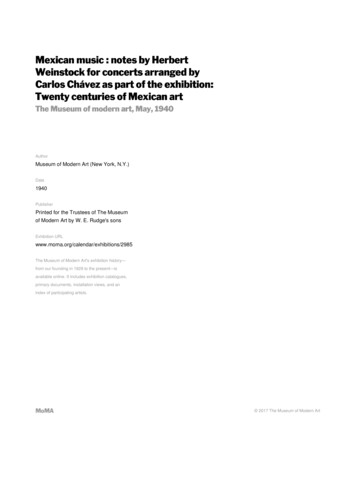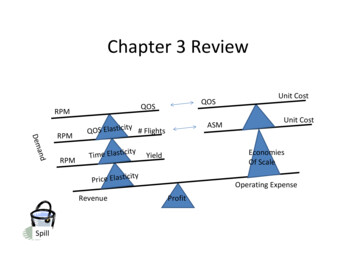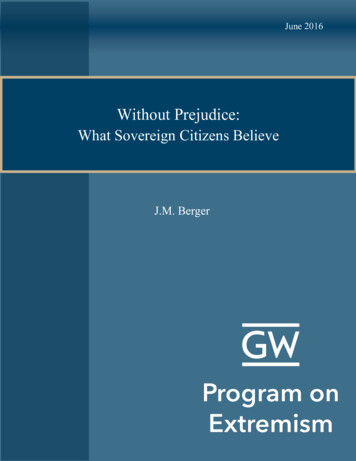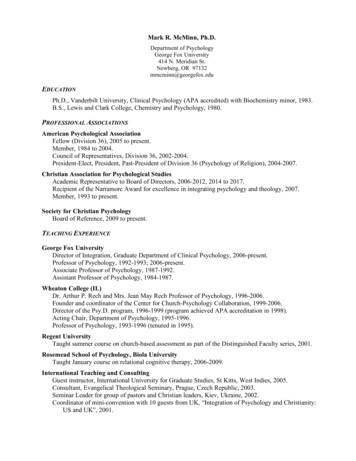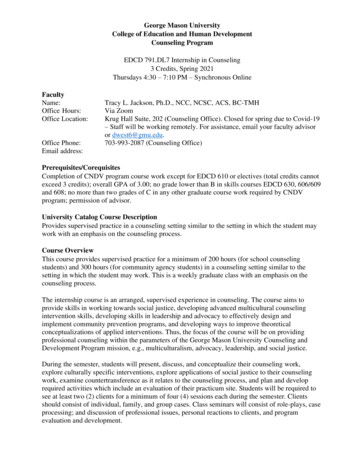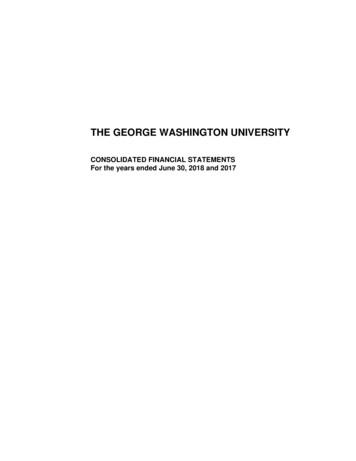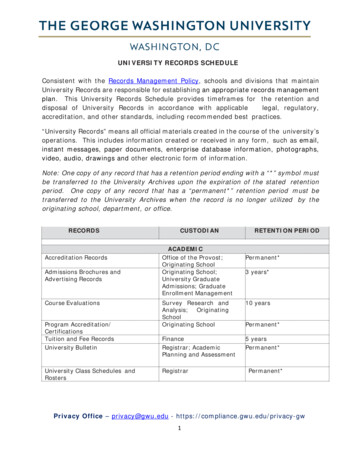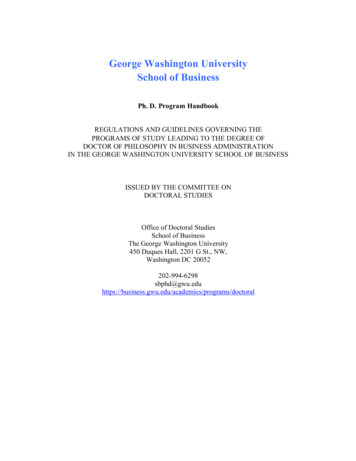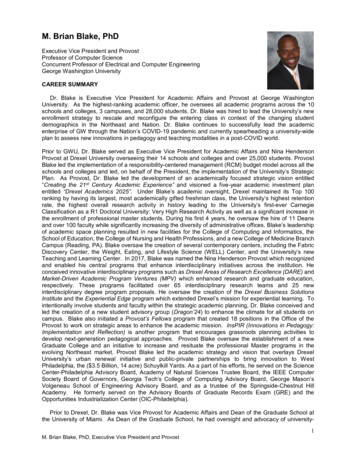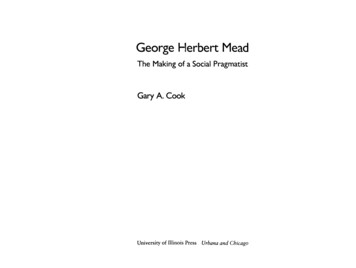
Transcription
George Herbert MeadThe Making of a Social PragmatistGary A. CookUniversity of Illinois Press Urbana and Chicago
ContentsAcknowledgments ixBibliographical Abbreviations xiIntroduction xiii1. Early Life and Letters: Part 1 12. Early Life and Letters: Part 2 203. From Hegelianism to Social Psychology 374. The Development of Mead's Social Psychology485. Behaviorism and Mead's Mature Social Psychology676 . Taking the Attitude or the Role of the Other 787. Mead and the City of Chicago: Social and Educational Reform8. Moral Reconstruction and the Social Self1159. Whitehead's Influence on Mead's Later Thought10. Mead's Social Pragmatism161Epilogue: Mead and the Hutchins ControversyNotes195BibliographyIndex 22721518313899
IntroductionThe work of the American philosopher and social psychologist GeorgeHerbert Mead (1863-1931) has been the object of growing scholarlyinterest from several different quarters in recent years. Sociologists andhistorians of the social sciences have been debating the legitimacy of hislong-standing honorary status as one of the founding fathers of symbolic interactionism in American sociology; they have devoted attention not only to his social psychological ideas but also to such mattersas his influence upon the Chicago School of sociology and his involvement in Progressive social reform.' Meanwhile, philosophers have increasingly come to regard him as one of the canonical figures in thehistory of American pragmatism; they have sought to specify his contributions to the pragmatic tradition and to assess the relevance of thesecontributions for issues of current concern.' And, in addition, certainGerman thinkers have begun to investigate Mead's writings with aneye to suggestions bearing upon their own research in the areas ofphilosophical psychology and critical social theory.'Despite the increasing attention being paid to his work, however,Mead's thought remains to this day an only partially explored territory.This is due in large measure to the often fragmentary character of hiswritings: "I am vastly depressed by my inability to write what I wantto," he lamented in a letter to his daughter-in-law late in his career."The distance between what I want and what I can is so unbridgeable.It is an ancient theme."4 Perhaps because of this inability, or because ofwhat his long-time friend and colleague John Dewey called "a certaindiffidence which restrained George Mead from much publication,"" henever published a systematic treatment of his many social psychological and philosophical insights. Anyone who wishes to do justice to thefull scope and coherence of Mead's intellect must therefore struggle to
xivIntroductiondiscern unifying threads running through the numerous short essaysand reviews he piiblished during his lifetime; he or she must furtherattempt to identify and find linkages between the central themes in asmall mountain of additional materials consisting mainly of unfinishedmanuscripts, corrcspondcncc, and student notes from iMead7smost important courses at the University of Chicago.It is just this sort of scholarly inquiry that I have undertaken in thepresent study. My approach here is essentially that of an intellectualhistorian: I a m primarily concerned to elucidate the meaning and cohercnce of Mcad's key ideas, and I seek to accomplish this by locating theseideas within a well-documcnted account of his development as botha thinker and a practitioner of educational and social reform. Thus, Ibegin my discussion of Mead's thought in chapters I and 2 by lookingcarcfully at his early life and letters. Here I trace the initial stages of hisintcllcctual development, from his undergraduate education a t Oberlin (:ollcge through thc beginning of his professional career as an instructor at thc llniversity of Michigan. These two largely biographicalchapters show what can he gleaned from historical documents aboutthe formative influence of Mead's early encounters with such iniportant teachcrs and colleagues as Josiah Koyce, George Herbert Palmer,William James, Wilhelm Dilthey, and John Dewey. The next severalchapters are devoted to the development of what I take to be the coreof Mead's thought, his social psychology. In these chapters 1 followMead's transition from an early Deweyan version of Hegelianism to aninterest in social psychology (chapter z), examine the deployment of hisdistinctive social psychological ideas in a series of essays he publishedearly in his cnrcer at the University of Chicago (chapter 4), and consider the culmination of these ideas in his mature social psychologicalwritings and lectures (chapters 5 and 6). Mead's social philosophy andethics arc taken up in chapters 7 and 8; the former chapter deals withhis involvemcnt in social and educational reform activities in the city of(Ihicago, while the latter surveys the development of his ideas on ethicsand moral psychology. Thc next two chapters address the continuingdevclopmcnt of Mcad's thought in the years following 1920: chapter 9 examines the various ways in which the writings of Alfred NorthWhitchcad inflilenccd the development of Mead's later thought, andchapter 10 sccks to supply a n overview of Mead's social pragmatism,especially as this relates to his mature understanding of experience,nature, and knowlcdge. Finally, the epilogue offers a biographical ac-Introductionxvcount of the end of Mead's career at the University of Chicago, focusingupon his involvement in a controversy between the department of philosophy and Robert Maynard Hutchins-a controversy that resultedin the virtual demise of the Chicago School of pragmatism.Although I shall occasionally refer to the secondary literature onMead's thought in the course of this study, I make no attempt t o survey this literature in a systematic fashion. Nor d o I attempt to assessthe various ways in which Mead's teaching and writing have influenced subsequent creative work in sociology and philosophy. Rather,my concern here is to dig deeply into Mead's own writings and relatedhistorical materials that shed light upon his intellectual developnlent.Since these primary documents are a heterogeneous lot, it may be helpful t o alert the reader in advance to some of their salient features andalso to indicate how they are to be utilized in what follows.Let me begin with the materials in the George Herbert Mead Papersat the Department of Special Collections at the Kegenstein Library ofthe University of Chicago. Of the many unpublished documents included in this collection, 1 have found particularly helpful Mead's earlyletters, which provide information about his years as an undergraduateat Oberlin College, his years of graduate study at Harvard, Leipzig,and Berlin, and the beginnings of his relationship with John Dewey atthe University of Michigan: the treatment of this period of his intellectual development found in chapters I and 2 is based in large part uponhis long correspondence with an Oberlin friend and subsequent intellectual companion, Henry Northrup Castle. Similarly, letters Meadwrote during the 1920s to his daughter-in-law, Irene Tufts Mead, werea source of information helpful in tracing the influence of Alfred NorthWhitehead's writings upon Mead's later thought. With very few exceptions, all of the better manuscripts (as opposed to personal correspondence) contained in the Mead Papers have been published in theposthu nousvolumes of Mead's works to be mentioned later; henceI have seldom had occasion to cite these manuscripts in their unpublished form. The Mead Papers also include a variety of student notestaken in Mead's courses at the University of Chicago. But, again, thebest of these have been posthumously published, and the others contain little that is relevant for my purposes; consequently I have citedthese unpublished student notes only in one or two cases. In addition,the Department of Special Collections at the Kegenstein Library housesseveral other collections containing materials related to Mead's career.
xviIntroductionI have drawn from the Henry Northrup Castle Papers in chapters I andz and also from the collection entitled Presidents' Papers ca. 192(--1q45in the epilogue dealing with the controversy between Hutchins and theChicago deprirtment of philosophy in the years immediately precedingMead's death.A second, and extremely important, category of Mead documentsconsists of the essays and book reviews Mead published in variousperiodicals. The bibliography ot his writings includes over ninety suchitems, at least forty of which are fairly substantive in character. Fora number of years these documents were largely overlooked in scholof Mead's thought, perhaps because they were notarly disc ssionsreadily accessible. But many of these publications have now been reprinted in two anthologies of Mead's essays edited, respectively, byAndrew ,J. Rcck" and John W. Petras.' I have relied heavily on theseessays throughout my book, and for two reasons. First, unlike muchof Mead's posthutnously published work, they hear definite datesa consideration of some importance when one is trying to trace thedevelopriient of an author's thought. Second, in contrast to studentlecturc notes and fragmentary manuscripts posthumously edited byothers, these documents were given their finishing touches by Meadhimself; presuninbly, therefore, they represent what he took to be hisbest work at the time of their submission for publication.A third category of documents pertaining to Mead's intellectual development consists o f official records of his remarks and actions as ameinbcr of various org;lnizations. In chapter 7,for instance, where Iexplore his involvement in organizations dedicated to social and educational reform, I draw upon such records as the University of Chicago Settlement Konrd Minutes\ind the Bulleti?rs of the City Club of(:hicago." Thcsc documents enable me to pin down with considerablespecificity the nature rind dates of Mead's reform activities.I.astly, there are the four volumes of Mead's work published in thedecade following his dcath in 1931. The first of these posthumous volumes, . I ? c PhilosopI yof the Present (1932). was edited by Arthur E.Murphy, one of Mend's colleag esat the University of Chicago. andwas published by thc Open Court Publishing Company as part of itsseries of Carus 1.cctures. Approxinlately half of this volunie consists ofMurphy's edited version of three Carus Lectures delivered by Mead atthe Pacific Llivision meeting of the American Philosophical Associationin LIcceniber rgjo. The remainder of the volume includes related ma-Introductionxviiterial drawn from several previously unpublished (and undated) manuscripts and from two essays published in the late 1920s. In chapter 9, Itry to show how the new ideas Mead tentatively explores here-especially in the portion of The Philosophy of the Present based upon the1930 Carus Lectures-grew out of his earlier work.Three additional posthumous volumes of Mead's work were published by the University of Chicago Press during the rgjos, due mainlyto the efforts of Mead's son and daughter-in-law. Convinced thatMead's lectures and manuscripts were of sufficient importance to deserve a wider audience, Henry and Irene Tufts Mead secured the services of Charles W. Morris and Merritt Hadden Moore to undertakethe task of selecting and editing suitable portions of Mead's unpublished work for posthumous publication."'From this editorial projectthere eventually issued two volumes based upon student notes takenin Mead's courses, Mind, Self and Society (1934) and Movements ofThought in the Nineteenth Century (1936), and a third volume containing previously unpublished manuscripts and fragments, The l'bilosophy of the Act (1938).The well-known Mind, Self and Society, as Charles Morris indicatesin his editorial preface, is based upon student notes taken in severaldifferent offerings of Mead's course on advanced social psychologyduring the years from 1927 to 1930. After rearranging and rewritingthese notes, Morris added a number of undated items he labeled supplementary essays. The most important of these, "Fragments on Ethics," isderived from a set of student notes taken in Mead's course on elementary ethics offered during the autumn quarter of 927." I have madesome use of this volume in chapters 5 and 6 , where I consider Mead'smature social psychology, as well as in chapters 8 and 10, dealing withthe development of Mead's views on ethics and his social pragmatism. But, in general, I have preferred to rest my analysis of his socialpsychology, ethics, and pragmatism upon the more secure ground ofmaterials actually written by Mead rather than upon reconstructionsof student notes.Moijements of Thought in the Nineteenth Century is based primarilyupon student notes taken in Mead's offering of the course by that nameduring the spring quarter of 1928. In addition, it contains some materialfrom student notes taken in Mead's course on the philosophy of Bergson in the summer quarter of 7927. For the most part, I have not foundhis discussions of nineteenth-century intellectual history to be particu-
xviiiintroductionlarly useful for my study. But Mead also ventures into such areas as thephilosophy of science, pragmatism, behaviorism, and social psychology in thc course of these lectures. And while he discusses all of thesetopics more fully in other places, his remarks in this volume sometimeshelp to clarify his mature views with respect to them. Hence, I haveoccasionally drawn relevant information from this work in connectionwith my treatment of these matters in the later chapters of my book.Of all the posthumously published volumes of Mead's work, themost problematic for the purposes of the present study is The Philosophy of the Act. It is problematic not because of the diversity of the manypreviously unpublished manuscripts and fragments it contains, but because all of these are undated. Professor Harold Orbach of Kansas StateUniversity is currently attempting to date these items on the basis ofvarious evidcnce, including the typescript and paper used in the original manuscripts; until the results of this enterprise have been madeavailable, however, we can do no better than to use the content of themost important of these manuscripts as a basis for assigning them anapproximate place in the chronology of Mead's work. One very helpfulclue in this regard is provided by the influence of Whitehead. As 1 showin chapter 9, Mead did not begin to read the writings of Whiteheaduntil the summer of 1921, and he did not begin to make references toWhitehead's ideas in his publications until 1925. Hence, we may safelyinfer that any of Mead's undated manuscripts that refer to Whitehead'sworks or that employ Whiteheadian terminology (and there are manysuch manuscripts included in The Philosophy of the Act) were composed no earlier than 1921 and probably somewhat later. I rely uponthis clue in my selection of items from this volume to supplement myuse of Mead's dated publications when I deal in chapters q and TO withhis philosophical explorations during the final decade of his life.One further comment about the posthumously published volumes of Mead'swork is in order before bringing this introduction to a close.David L. Miller has edited an additional volume of Mead's previouslyunpublished work under the title The Individual and the Social Self,published by the University of Chicago Press in 1982. The main bodyof this volume consists of Miller's edited version of two sets of student notes taken in Mead's courses on social psychology and preservedamong the Mend Papers at the Regenstein Library. Miller identifies thefirst of thcsc as heing from Mcad's course of 1914 (although, in fact, itdates from thc fall quarter of 1912); the second set of notes was taken inIntroductionxixMead's course on advanced social psychology during the winter quarter of 1927.In addition, the volume includes an undated twenty-pagemanuscript that Miller has entitled "Consciousness, Mind, the Self, andScientific Objects," and an appendix of commentary on Mead's workby an author Miller is unable to identify." None of these documents,as far as I can see, adds much substance to the materials already mentioned above-although the student notes presented here d o provide ahelpful supplement to those used in the composition of Mind. Self andSociety. But, again, I have chosen to rest my analysis of Mead's socialpsychology primarily upon relevant essays he published in various journals rather than upon reconstructions of student notes: thus I haveseldom cited Miller's volume in my examination of Mead's intellectualdevelopment.
The work of the American philosopher and social psychologist George Herbert Mead (1863-1931) has been the object of growing scholarly interest from several different quarters in recent years. Sociologists and historians of the social

